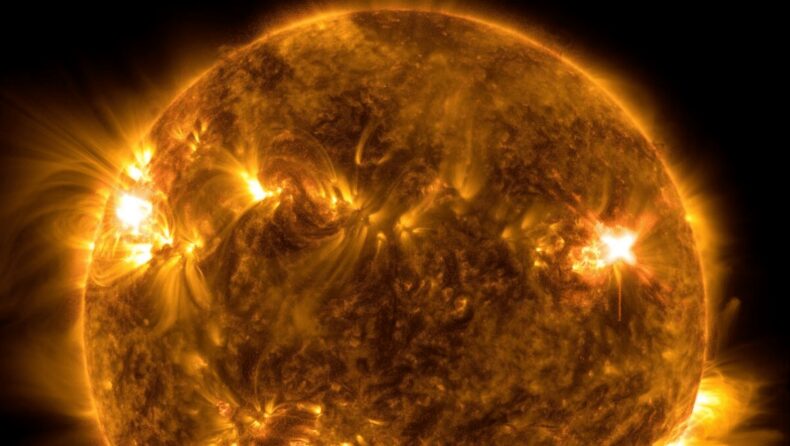A Coronal Mass Ejection from the sun is on its way to Earth. Heavy auroras and geometric storms are expected to be experienced as a part of it.
Countless coronal mass ejections (CMEs) from the sun are anticipated to reach Earth’s surface, as per National Oceanic and Atmospheric Administration (NOAA) forecasts.
The magnetic action on the Sun’s corona (the uppermost part of its atmosphere) induces it to erupt on a regular basis, releasing plasma and magnetic fields into space, resulting in a CME.
It’s also plausible that this is a cannibal CME, which occurs when a rapidly moving CME intersects with slower CMEs in front of it.

After exploding with a cannibal explosion, the Sun has emitted a 2,00,000-kilometer-long filament eruption, pertaining to observatories. The long magnetic filament erupted from the Sun’s southern hemisphere, snapping like that of a rubber band.
The solar flare also hampered rescue efforts for those who had become trapped as a result of Hurricane Ian. There were lots of blackouts all across the USA, while the mobile networks and radio channels were also knocked out.
The delay due to the radiation resulted in the loss of many people’s lives and properties. Since it distorts the radio frequencies, the GPS locator will also be irregular and less dependent. Soon we will enter the Solar Maximum. It is a time when solar flares are at their peak and have the potential to cause a massive disaster if they strike Earth.
A Geomagnetic storm and a CME
A geomagnetic storm happens when a solar ejecta comes into contact with the earth’s electromagnetic field. This can trigger voltage alarms and transformer damage in high-altitude power sources.
At 1:55 a.m. on October 22,2022, NASA’s Solar Dynamic Observatory recorded the sun emitting an intense solar flare. The flare has been labelled as an X1 flare, where the X-class indicates the most severe flares and the number denotes its vigour.
Solar flares, however, are powerful bouts of energy that can disrupt radio communications, power grids, and navigation signals. It also poses a dangerous threat to the astronauts as well as the spacecraft.
This year, the Sun, which is in the middle of its 11-year solar cycle, seems to have been incredibly active as it approaches the apex of its solar cycle. Many solar flares have hit Earth in the last few months, and more are on the way.
The Cannibal eruption has the potential to cause severe auroras and obstruct radio frequencies. Some experts estimate a G2 geomagnetic storm, which is a major disruption of the Earth’s magnetosphere caused by energy being swapped very efficiently into the space environment that surrounds Earth.
A Coronal Mass Ejection seems to be the discharge of a huge amount of plasma and magnetic field from the corona of the Sun. CMEs can eject billions of tonnes of coronal material, which typically travels far away from the Sun at a maximum speed of less than 250 kilometres per second to nearly 3000 kilometres per second.
The Solar Dynamics Observatory detected strong solar flares on Tuesday around 1:55 a.m., which has been evaluating progress on the star in our solar system. The flare was classified as an X1, where X denotes the most severe type of flare and the volume denotes its strength.
The Indian Institute of Science Education and Research (IISER) Kolkata’s Center of Excellence in Space Sciences has also been monitoring the Sun’s activity.
Another one of the sun’s largest sunspots, too, has tilted over the northeastern limb recently. AR3112 has over a dozen dark cores spread across 130,000 kilometers of the solar surface. According to astronomers, the sunspot is unsteady and might cause 2 weeks of increased solar activity.













